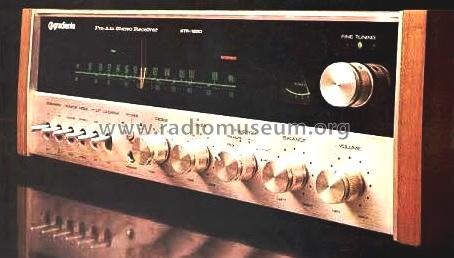Fm-Am Stereo Receiver STR-1250
Gradiente Eletrônica S.A.; São Paulo
- Paese
- Brasile
- Produttore / Marca
- Gradiente Eletrônica S.A.; São Paulo
- Anno
- 1974 ?
- Categoria
- Radio (o sintonizzatore del dopoguerra WW2)
- Radiomuseum.org ID
- 331388
Clicca sulla miniatura dello schema per richiederlo come documento gratuito.
- Numero di transistor
- A semiconduttori.
- Semiconduttori
- Principio generale
- Supereterodina (in generale)
- Gamme d'onda
- Onde medie (OM) e MF (FM).
- Particolarità
- Hi-Fi equipment
- Tensioni di funzionamento
- Alimentazione a corrente alternata (CA) / 110; 220 Volt
- Altoparlante
- - Questo apparecchio richiede altoparlante/i esterno/i.
- Potenza d'uscita
- 64 W (indistorta)
- Materiali
- Mobile in legno
- Radiomuseum.org
- Modello: Fm-Am Stereo Receiver STR-1250 - Gradiente Eletrônica S.A.; São
- Forma
- Apparecchio per ripiani a scaffale (come i componibili HiFi).
- Dimensioni (LxAxP)
- 430 x 140 x 350 mm / 16.9 x 5.5 x 13.8 inch
- Annotazioni
-
Inputs: Phono (moving magnet), Tape, Aux and Mic
Output power: 2 x 32 W RMS into 8 Ω, 2 x 40 W RMS into 4 Ω
AC outlets: 2 (110 - 220 V)There are different versions of this receiver, namely with the following prints on the back:
- IGB - Amazonia S/A., Av. Assai
Industria Brasileira, C.G.C. 04.209.912/0001-29
Produzida na Zona Francia de Manaus
- Made in Brazil
The schematic indicates:
- Gradiente - Receiver STR 1250 C / Monobloco Alps
- IGB - Amazonia S/A., Av. Assai
- Peso netto
- 10.2 kg / 22 lb 7.5 oz (22.467 lb)
- Autore
- Modello inviato da Antonio Rabitti. Utilizzare "Proponi modifica" per inviare ulteriori dati.
- Altri modelli
-
In questo link sono elencati 34 modelli, di cui 34 con immagini e 5 con schemi.
Elenco delle radio e altri apparecchi della Gradiente Eletrônica S.A.; São Paulo
Discussioni nel forum su questo modello: Gradiente Eletrônica: Fm-Am Stereo Receiver STR-1250
Argomenti: 1 | Articoli: 1
With reference to the product Gradiente model STR-1250 it was added in the text by the administrators that this model probably has Japanese parts. This is not correct. Gradiente produced this model (and others that I'll upload) entirely.
What happens is that our hi-fi audio market followed Japanese standards mainly with regard to connections.
Philips unsuccessfully tried to impose the DIN standard, but had to surrender to the market imposition created by other local hi-fi audio manufacturers (Gradiente, Polyvox, Quasar, CCE, Spectro, Gavox, Greynolds, etc.) who adopted the Japanese standard for connections .
Antonio Rabitti
Mike Edwards † 25.10.21, 08.Aug.21


